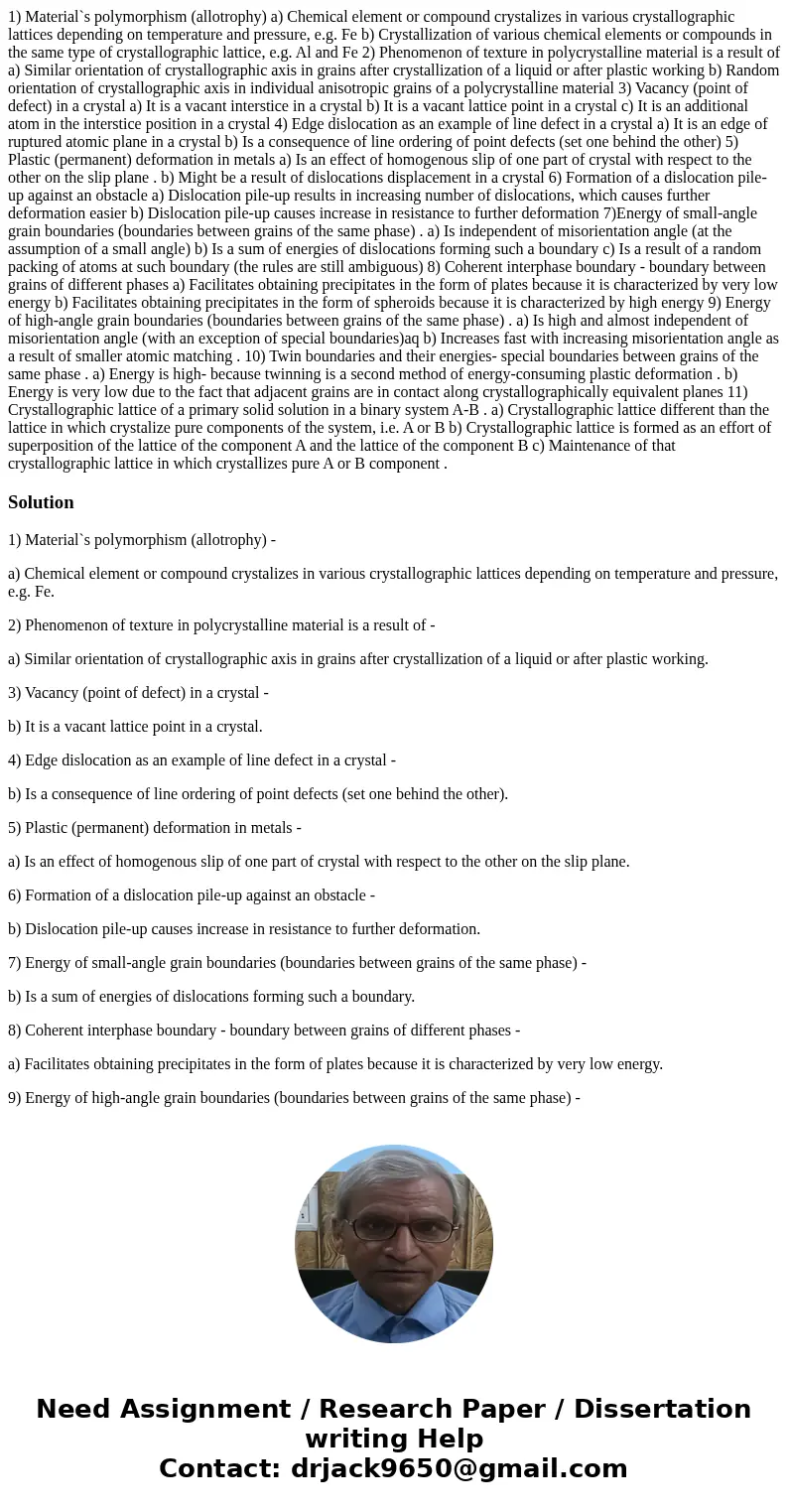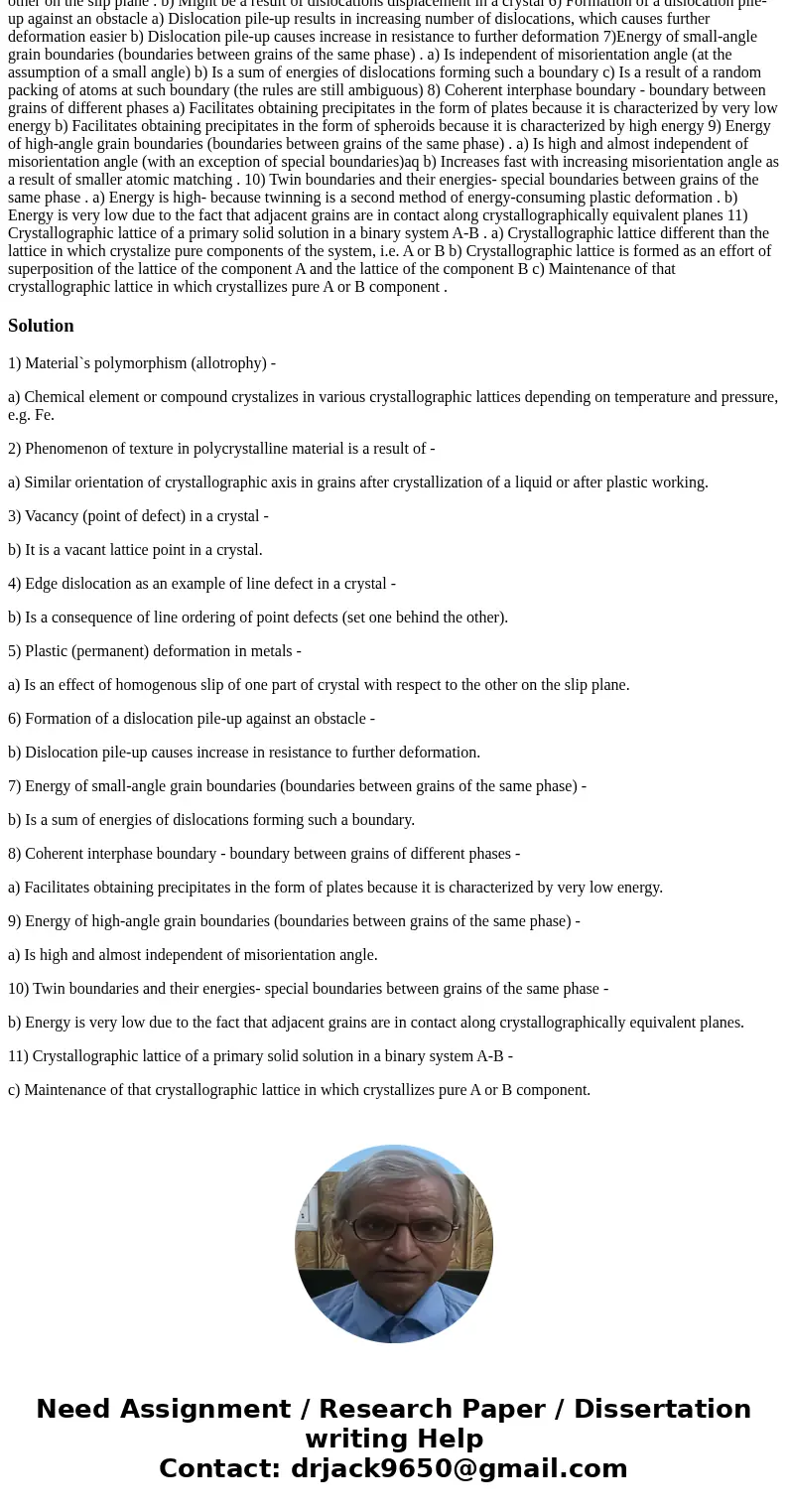1) Material`s polymorphism (allotrophy) a) Chemical element or compound crystalizes in various crystallographic lattices depending on temperature and pressure, e.g. Fe b) Crystallization of various chemical elements or compounds in the same type of crystallographic lattice, e.g. Al and Fe 2) Phenomenon of texture in polycrystalline material is a result of a) Similar orientation of crystallographic axis in grains after crystallization of a liquid or after plastic working b) Random orientation of crystallographic axis in individual anisotropic grains of a polycrystalline material 3) Vacancy (point of defect) in a crystal a) It is a vacant interstice in a crystal b) It is a vacant lattice point in a crystal c) It is an additional atom in the interstice position in a crystal 4) Edge dislocation as an example of line defect in a crystal a) It is an edge of ruptured atomic plane in a crystal b) Is a consequence of line ordering of point defects (set one behind the other) 5) Plastic (permanent) deformation in metals a) Is an effect of homogenous slip of one part of crystal with respect to the other on the slip plane . b) Might be a result of dislocations displacement in a crystal 6) Formation of a dislocation pile-up against an obstacle a) Dislocation pile-up results in increasing number of dislocations, which causes further deformation easier b) Dislocation pile-up causes increase in resistance to further deformation 7)Energy of small-angle grain boundaries (boundaries between grains of the same phase) . a) Is independent of misorientation angle (at the assumption of a small angle) b) Is a sum of energies of dislocations forming such a boundary c) Is a result of a random packing of atoms at such boundary (the rules are still ambiguous) 8) Coherent interphase boundary - boundary between grains of different phases a) Facilitates obtaining precipitates in the form of plates because it is characterized by very low energy b) Facilitates obtaining precipitates in the form of spheroids because it is characterized by high energy 9) Energy of high-angle grain boundaries (boundaries between grains of the same phase) . a) Is high and almost independent of misorientation angle (with an exception of special boundaries)aq b) Increases fast with increasing misorientation angle as a result of smaller atomic matching . 10) Twin boundaries and their energies- special boundaries between grains of the same phase . a) Energy is high- because twinning is a second method of energy-consuming plastic deformation . b) Energy is very low due to the fact that adjacent grains are in contact along crystallographically equivalent planes 11) Crystallographic lattice of a primary solid solution in a binary system A-B . a) Crystallographic lattice different than the lattice in which crystalize pure components of the system, i.e. A or B b) Crystallographic lattice is formed as an effort of superposition of the lattice of the component A and the lattice of the component B c) Maintenance of that crystallographic lattice in which crystallizes pure A or B component .
1) Material`s polymorphism (allotrophy) -
a) Chemical element or compound crystalizes in various crystallographic lattices depending on temperature and pressure, e.g. Fe.
2) Phenomenon of texture in polycrystalline material is a result of -
a) Similar orientation of crystallographic axis in grains after crystallization of a liquid or after plastic working.
3) Vacancy (point of defect) in a crystal -
b) It is a vacant lattice point in a crystal.
4) Edge dislocation as an example of line defect in a crystal -
b) Is a consequence of line ordering of point defects (set one behind the other).
5) Plastic (permanent) deformation in metals -
a) Is an effect of homogenous slip of one part of crystal with respect to the other on the slip plane.
6) Formation of a dislocation pile-up against an obstacle -
b) Dislocation pile-up causes increase in resistance to further deformation.
7) Energy of small-angle grain boundaries (boundaries between grains of the same phase) -
b) Is a sum of energies of dislocations forming such a boundary.
8) Coherent interphase boundary - boundary between grains of different phases -
a) Facilitates obtaining precipitates in the form of plates because it is characterized by very low energy.
9) Energy of high-angle grain boundaries (boundaries between grains of the same phase) -
a) Is high and almost independent of misorientation angle.
10) Twin boundaries and their energies- special boundaries between grains of the same phase -
b) Energy is very low due to the fact that adjacent grains are in contact along crystallographically equivalent planes.
11) Crystallographic lattice of a primary solid solution in a binary system A-B -
c) Maintenance of that crystallographic lattice in which crystallizes pure A or B component.


 Homework Sourse
Homework Sourse